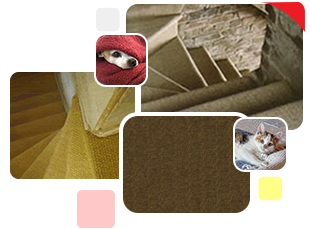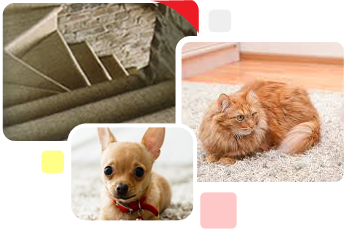Wool Carpets - the superior fibre for wear?
There are many assumptions about wool carpets, and it is not always easy to unravel fact from fiction - equally respected parties frequently contradict each other. I will try to provide factual information useful for buying choices here...
Whatever the opinions out there...you can't go wrong with wool
That's right, we sell more wool carpet than anything else and always have done. The American's, by contrast are apparently only just discovering it in response to environmental concerns.


Unlike man made fibres, wool is opaque and therefore hides soiling better than its unnatural, transparent counterparts. The actual fibres have scaly edges which also tend to hide small dirt particles. This has been a problem for manufacturers of man made fibres whose transparency has needed much technical development over the years.
Wool cells come in two types - the paracortex and the orthcortex - with each type growing on opposite sides of the fibre and at slightly different rates. Whilst this may be starting to get too technical for carpet buyers, it is the very real basis of wools natural ability to recover from compression wear.
Indeed, wool responds very well to cleaning - wool fibres recover naturally from footfall compression. Like man made fibres, wool is vulnerable to stains similar to its own chemical make up. As polypropylene is a by product of petroleum refining (and hence damaged by oil/petrol stains), wool is essentially a protein and is vulnerable to meat juices, pet soiling, blood etc.
If stains are tackled promptly damage is minimised or even negated, it is when they are left that real damage can occur (beware of teenagers). Take care of wool and it will prove a time tested carpet of real value.
I asked a rep from a very respected carpet manufacturer this question shortly before writing this page. The reply was that adding 20% man made fibre was originally done to cut costs on the more expensive wool fibres and this ratio has become the accepted blend for consumer taste (by custom).
Other research I have done indicates that man made fibres are likely to play a role in the actual setting of the "twist" and the bonding of the tufts into the backing. This can require heat treatment setting, something that wool does not respond to owing to its inability to melt. This inability is an advantage for wool resisting burn and melt damage such as cigarettes or grate embers.
Useful buying advice would be to consider which man made fibre the wool is being mixed with. Nylon is the best and will usually be a factor in differing prices between otherwise similar looking carpets. Nylon does have a superior resistance over polypropylene for bouncing back from compression.
Polypropylene has a greater resistance to staining - consider which is likely to be the biggest issue for your lifestyle when choosing a mix. Occasionally you will see polyester refered to as a component in a blended carpet. This is most likely going to refer to fibre wound around the tuft base and not necessarily as part of what gets stepped upon.
Unlike man made fibres, you may need to consider the organic problems of wool. Wool is a protein and makes excellent nutrition for moths, mites and mould spores.
Some manufacturers treat carpets to overcome these drawbacks so if you have a ravenous moth population or are allergic to wool dust, consider asking for these brands (we'll gladly show you some at Tony Mustoe's Carpets).

Think in terms of these widths
Coir is primarily available in a 4.00 metre (13') width but it is important to note that width tolerances are a factor here. The Alternative Trading Company state 4.00 metre widths with the caveat that this could be plus or minus 1%.
Crucial Trading do it differently, they state the width as sold at 3.94 metres minimum (although in practice we know it is often wider than this). Some of the natural colours are also sold as 5.00 metres (16'5").
The Alternative Flooring Company offer a 2.00 metre width (6'6") which is cut down from 4.00 metre widths. This means that there will inevitably be one salvage edge missing.
Where the sheep are born and bred is often touted by manufacturers and their reps as a significant factor though question them about this and few (if any) will know why.
Research via the wool marketing board provided me with the answer - it is the same as grapes and wine growing - the more sheep have to struggle to live, the better the quality of their wool. British and New Zealand wools are considered to be the best, British wool being particularly hard wearing and New Zealand being superior for dyeing.
Cheaper wool carpets inevitably contain wool garnered from sunnier climates such as Portugal and Greece. Wool which comes from these global proximities is a good bargain if it has two ply construction - this helps compensate for any loss of durability British and New Zealand wool would otherwise have.
Whilst serving customers, I always joke that nylon has changed considerably in the last two decades whilst sheep have not....

